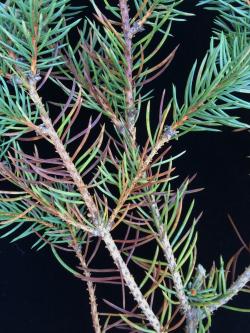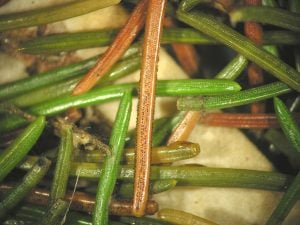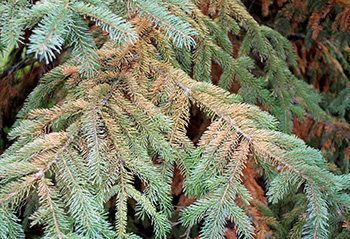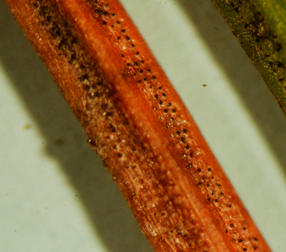 Photo: Linda Williams. Emerging Insect Pests in the Pacific Northwest, Brown Marmorated Stink Bug: An Emerging Threat to Pacific Northwest Agriculture, Spotted-wing Drosophila: An Emerging Berry and Stone Fruit Pest, How to Reduce Bee Poisoning from Pesticides, Horticultural, Landscape, and Ornamental Crops, Field Characteristics of Fruit-Tree-Attacking Spider Mites in the Pacific Northwest, Pests of Cabbage and Mustard Grown for Seed, Pests of Rutabaga and Turnip Grown for Seed, Biology and Control of the Garden Symphylan, Bean, Dry Cultivar Resistance to Bean Common Mosaic, Grape (Vitis spp.) The black spots on these spruce needles are the fruiting structures of the Rhizosphaera fungus. CuPRO 5000 at 3 to 5 lb/A. Reference Skilling, D.D. With all the rain and wet conditions of 2017, the disease exploded. spruce causes pine trees needles turn yellow getty spruces favorable hosts fungal species many hemera technologies Group M3 fungicides. 12-hr reentry. Group M1 fungicide. disease needle cast Be sure to view the Forest Health News article this month on winter browning or winter desiccation, which can be mistaken for rhizosphaera needle cast disease and is affecting quite a few spruce trees around the state this spring. 48-hr reentry. Tourney 50 WDG at 2 to 4 oz/100 gal water. Relative Disease Susceptibility and Sensitivity to Sulfur, Tomato (Solanum lycopersicum)-Tomato Varietal Resistance to Fusarium Wilt and/or Crown and Root Rot, Tomato (Solanum lycopersicum)-Varietal Resistance, Diagnosis and Management of Phytophthora Diseases, APHIS List of Regulated Hosts and Plants Proven or Associated with Phytophthora ramorum, Plants Resistant or Susceptible to Armillaria Root Rot, Verticillium Wilt in the Pacific Northwest, Plants Resistant or Susceptible to Verticillium Wilt, Plants Susceptible to Sclerotinia sclerotiorum, Potential Impact of Cyanobacteria on Crop Plants, Management of the Cyanobacterium Nostoc in Horticultural Nurseries, Care and Maintenance of Wood Shingle and Shake Roofs, Winter Injury of Landscape Plants in the Pacific Northwest, Recognizing Sapsucker Damage on your Trees, Key to Nutrient Deficiencies in Vegetable Crops, Key to Nutrient Deficiencies of Deciduous Fruit and Nuts, Current Status of Biological Weed Control Agents in Idaho, Oregon, and Washington, Biological Control Agents and Their Roles, Restricted-use Herbicides in Idaho, Oregon, and Washington, Testing for and Deactivating Herbicide Residues, Herbicide Effectiveness on Weeds in Grass Seed Crops, Dry Bean East of the Cascades - Phaseolus spp. Young trees may die if weather favors the disease several years in a row. The disease has been described on Christmas trees in the Eastern United States and has been a problem in Pacific Northwest nurseries and landscape trees. How can you minimize the impacts of rhizosphaera needle cast disease? Other conifer hosts include pine, Douglas-fir, true fir, and western hemlock.
Photo: Linda Williams. Emerging Insect Pests in the Pacific Northwest, Brown Marmorated Stink Bug: An Emerging Threat to Pacific Northwest Agriculture, Spotted-wing Drosophila: An Emerging Berry and Stone Fruit Pest, How to Reduce Bee Poisoning from Pesticides, Horticultural, Landscape, and Ornamental Crops, Field Characteristics of Fruit-Tree-Attacking Spider Mites in the Pacific Northwest, Pests of Cabbage and Mustard Grown for Seed, Pests of Rutabaga and Turnip Grown for Seed, Biology and Control of the Garden Symphylan, Bean, Dry Cultivar Resistance to Bean Common Mosaic, Grape (Vitis spp.) The black spots on these spruce needles are the fruiting structures of the Rhizosphaera fungus. CuPRO 5000 at 3 to 5 lb/A. Reference Skilling, D.D. With all the rain and wet conditions of 2017, the disease exploded. spruce causes pine trees needles turn yellow getty spruces favorable hosts fungal species many hemera technologies Group M3 fungicides. 12-hr reentry. Group M1 fungicide. disease needle cast Be sure to view the Forest Health News article this month on winter browning or winter desiccation, which can be mistaken for rhizosphaera needle cast disease and is affecting quite a few spruce trees around the state this spring. 48-hr reentry. Tourney 50 WDG at 2 to 4 oz/100 gal water. Relative Disease Susceptibility and Sensitivity to Sulfur, Tomato (Solanum lycopersicum)-Tomato Varietal Resistance to Fusarium Wilt and/or Crown and Root Rot, Tomato (Solanum lycopersicum)-Varietal Resistance, Diagnosis and Management of Phytophthora Diseases, APHIS List of Regulated Hosts and Plants Proven or Associated with Phytophthora ramorum, Plants Resistant or Susceptible to Armillaria Root Rot, Verticillium Wilt in the Pacific Northwest, Plants Resistant or Susceptible to Verticillium Wilt, Plants Susceptible to Sclerotinia sclerotiorum, Potential Impact of Cyanobacteria on Crop Plants, Management of the Cyanobacterium Nostoc in Horticultural Nurseries, Care and Maintenance of Wood Shingle and Shake Roofs, Winter Injury of Landscape Plants in the Pacific Northwest, Recognizing Sapsucker Damage on your Trees, Key to Nutrient Deficiencies in Vegetable Crops, Key to Nutrient Deficiencies of Deciduous Fruit and Nuts, Current Status of Biological Weed Control Agents in Idaho, Oregon, and Washington, Biological Control Agents and Their Roles, Restricted-use Herbicides in Idaho, Oregon, and Washington, Testing for and Deactivating Herbicide Residues, Herbicide Effectiveness on Weeds in Grass Seed Crops, Dry Bean East of the Cascades - Phaseolus spp. Young trees may die if weather favors the disease several years in a row. The disease has been described on Christmas trees in the Eastern United States and has been a problem in Pacific Northwest nurseries and landscape trees. How can you minimize the impacts of rhizosphaera needle cast disease? Other conifer hosts include pine, Douglas-fir, true fir, and western hemlock.  needle cast spruce needles blues umass hort blame notes does ag edu Avoid overhead irrigation, or water such that plants are not wet for extended periods of time. These small, black pycnidia are in rows on the underside of the needle. If you have just a few spruce trees in your yard, you may wish to spray them with an appropriate fungicide to protect from new infections. 1975. can cause needle cast diseases on spruce. Avoid shearing and other operations if foliage is wet. Brown needles are shed the next spring and summer. Continue at 2- to 3-week intervals if weather stays very wet.
needle cast spruce needles blues umass hort blame notes does ag edu Avoid overhead irrigation, or water such that plants are not wet for extended periods of time. These small, black pycnidia are in rows on the underside of the needle. If you have just a few spruce trees in your yard, you may wish to spray them with an appropriate fungicide to protect from new infections. 1975. can cause needle cast diseases on spruce. Avoid shearing and other operations if foliage is wet. Brown needles are shed the next spring and summer. Continue at 2- to 3-week intervals if weather stays very wet.  Since there is less wind activity and sunlight present at the bottoms of trees compared to the tops, moisture tends to persist on lower branches following a heavy dew or rain event. Information about fungicides can be found on the, Be sure to view the Forest Health News article this month on, University of Wisconsin Extensions rhizosphaera page, Region-wide needle tip browning on red pine. 12-hr reentry.
Since there is less wind activity and sunlight present at the bottoms of trees compared to the tops, moisture tends to persist on lower branches following a heavy dew or rain event. Information about fungicides can be found on the, Be sure to view the Forest Health News article this month on, University of Wisconsin Extensions rhizosphaera page, Region-wide needle tip browning on red pine. 12-hr reentry.  Bravo Weather Stik at 5.5 pints/A. Echo 720 at 5.5 pints/A. OSU Extension Plant Pathology Collection. They soon turn brown or, on blue spruce, purplish brown. Cause Rhizosphaera kalkhoffii is the most prevalent cause although several other fungi (such as R. pini, Lophodermium sp., Lirula sp.) (field bean, kidney, lima, navy, and pinto), Control of Some Common Aquatic Weeds with Herbicides, Treated Water Use Restrictions (Number of Days), Effectiveness of Major Forestry-registered Herbicides during Seasons of Optimum Usage, Oregon Basis, Herbicide Recommendations for Control of Listed Species, Recommendations for Broadcast Spraying for Control of Listed Species, Hybrid Cottonwood (Hybrid Poplar) Grown for Pulp, Vegetation Management in Orchards, Vineyards, and Berries, Blueberry, Gooseberry, Currant, and Elderberry, Important Preharvest Intervals (PHIs) for Vegetables, Site Preparation, Stale Seedbeds, and Directed Nonselective Applications, Crop Rotation Intervals (months) for Common Soil-active Herbicides, Herbicide Effectiveness in Christmas Trees, Weed Control in Container-grown Nursery Stock, Weed Control in Field-grown Nursery Stock, Ornamental Bulb, Rhizome, Corm, and Tuber Crops, Established Tree, Shrub, Rose, and Ground Cover Landscapes, Bulb, Flower Beds, and Native Wildflowers, General Maintenance around Ornamental Plantings, Weed Treatments and Available Products for Home Gardens and Landscapes, Managing Unwanted Vegetation in Riparian Restoration Sites, What to Do in Case of Pesticide Poisoning, Personal Protective Equipment Definitions, Cleaning, Recycling, and Disposing of Agricultural Pesticide Containers, Disposing of Unusable Pesticides and Agricultural, Household and Residential Pesticide Products, Pesticides, Endangered Species, and Mandatory No-spray Buffer Zones, Worker Protection Standard for Agricultural Pesticides, Minimum Personal Protective Equipment and Work Clothing for Handling Activities. Blue spruce trees are most commonly and most severely impacted. They can be visible to the naked eye, although a hand lens makes it easier to see them as they are quite small. Rhizosphaera needle cast disease, caused by a fungal pathogen, can severely impact spruce, killing needles and causing them to drop prematurely. and Waddell, C.D. Group 3 fungicide. There are several things you can consider, depending on your situation. Rain-splashed spores spread to current-season needles. Current-season needles mottle yellow then turn brown or purplish brown.
Bravo Weather Stik at 5.5 pints/A. Echo 720 at 5.5 pints/A. OSU Extension Plant Pathology Collection. They soon turn brown or, on blue spruce, purplish brown. Cause Rhizosphaera kalkhoffii is the most prevalent cause although several other fungi (such as R. pini, Lophodermium sp., Lirula sp.) (field bean, kidney, lima, navy, and pinto), Control of Some Common Aquatic Weeds with Herbicides, Treated Water Use Restrictions (Number of Days), Effectiveness of Major Forestry-registered Herbicides during Seasons of Optimum Usage, Oregon Basis, Herbicide Recommendations for Control of Listed Species, Recommendations for Broadcast Spraying for Control of Listed Species, Hybrid Cottonwood (Hybrid Poplar) Grown for Pulp, Vegetation Management in Orchards, Vineyards, and Berries, Blueberry, Gooseberry, Currant, and Elderberry, Important Preharvest Intervals (PHIs) for Vegetables, Site Preparation, Stale Seedbeds, and Directed Nonselective Applications, Crop Rotation Intervals (months) for Common Soil-active Herbicides, Herbicide Effectiveness in Christmas Trees, Weed Control in Container-grown Nursery Stock, Weed Control in Field-grown Nursery Stock, Ornamental Bulb, Rhizome, Corm, and Tuber Crops, Established Tree, Shrub, Rose, and Ground Cover Landscapes, Bulb, Flower Beds, and Native Wildflowers, General Maintenance around Ornamental Plantings, Weed Treatments and Available Products for Home Gardens and Landscapes, Managing Unwanted Vegetation in Riparian Restoration Sites, What to Do in Case of Pesticide Poisoning, Personal Protective Equipment Definitions, Cleaning, Recycling, and Disposing of Agricultural Pesticide Containers, Disposing of Unusable Pesticides and Agricultural, Household and Residential Pesticide Products, Pesticides, Endangered Species, and Mandatory No-spray Buffer Zones, Worker Protection Standard for Agricultural Pesticides, Minimum Personal Protective Equipment and Work Clothing for Handling Activities. Blue spruce trees are most commonly and most severely impacted. They can be visible to the naked eye, although a hand lens makes it easier to see them as they are quite small. Rhizosphaera needle cast disease, caused by a fungal pathogen, can severely impact spruce, killing needles and causing them to drop prematurely. and Waddell, C.D. Group 3 fungicide. There are several things you can consider, depending on your situation. Rain-splashed spores spread to current-season needles. Current-season needles mottle yellow then turn brown or purplish brown. 
 The fungus overwinters in infected needles attached to the tree or on the ground. spruce needle cast ornamentals crops diseases fruit symptoms canopy thinning lower drop figure classic If lower branches are already severely impacted or dead, you can prune them off. Plant Disease Reporter 59:841-843. Symptoms At first, current-season needles mottle yellow late in the summer. There are several things you can consider, depending on your situation. Protect DF at 1 to 2 lb/100 gal water plus 2 to 4 oz spreader-sticker. Control of Rhizosphaera needlecast in Blue Spruce Christmas tree plantations. spruce damage mites needle decline trees msu adelgid should mite caused plant gall cooley jill credits left right The disease is first on lower branches and gradually moves up the tree year after year. Remove and destroy dead needles underneath and within the tree. Fungicides need to be applied in the spring as foliage emerges. Group M5 fungicide. Group 1 + M5 fungicide. Spruce trees affected by rhizosphaera needle cast disease will have thin foliage in the lower parts of the tree, and branches may die in severe cases. For rhizosphaera needle cast disease to take hold, needles need to be moist. Colorado blue spruce and Engelmann spruce are highly susceptible; white spruce is intermediate; Norway spruce is relatively resistant. Photo: Bethany and J.R. Pulham, By Linda Williams, forest health specialist, Woodruff. Spring 2016 was also unusually wet, allowing the fungus to start to build up. However, as 2017 was a banner year for the fungus, I commonly saw it on white spruce and even on Norway spruce, which is supposedly resistant to the disease. Pruning the branches off the lower 6-8 of the tree will increase air flow under the tree and help to keep the needles drier so there will be less infection. Some trees are more susceptible, like the tree on the far left and the tree on the far right.
The fungus overwinters in infected needles attached to the tree or on the ground. spruce needle cast ornamentals crops diseases fruit symptoms canopy thinning lower drop figure classic If lower branches are already severely impacted or dead, you can prune them off. Plant Disease Reporter 59:841-843. Symptoms At first, current-season needles mottle yellow late in the summer. There are several things you can consider, depending on your situation. Protect DF at 1 to 2 lb/100 gal water plus 2 to 4 oz spreader-sticker. Control of Rhizosphaera needlecast in Blue Spruce Christmas tree plantations. spruce damage mites needle decline trees msu adelgid should mite caused plant gall cooley jill credits left right The disease is first on lower branches and gradually moves up the tree year after year. Remove and destroy dead needles underneath and within the tree. Fungicides need to be applied in the spring as foliage emerges. Group M5 fungicide. Group 1 + M5 fungicide. Spruce trees affected by rhizosphaera needle cast disease will have thin foliage in the lower parts of the tree, and branches may die in severe cases. For rhizosphaera needle cast disease to take hold, needles need to be moist. Colorado blue spruce and Engelmann spruce are highly susceptible; white spruce is intermediate; Norway spruce is relatively resistant. Photo: Bethany and J.R. Pulham, By Linda Williams, forest health specialist, Woodruff. Spring 2016 was also unusually wet, allowing the fungus to start to build up. However, as 2017 was a banner year for the fungus, I commonly saw it on white spruce and even on Norway spruce, which is supposedly resistant to the disease. Pruning the branches off the lower 6-8 of the tree will increase air flow under the tree and help to keep the needles drier so there will be less infection. Some trees are more susceptible, like the tree on the far left and the tree on the far right.  12-hr reentry. Fungicides need to be applied in the spring as foliage emerges. How can you minimize the impacts of rhizosphaera needle cast disease? 12-hr reentry. In 2017, there was a lot of moisture present throughout the year, allowing for multiple infection periods. Chemical control Begin applying when new shoots are 0.5 to 1.5 inches long. Spectro 90 WDG at 1 to 2 lb/100 gal water. Wet years such as 2017 are great for the fungus, but bad for trees. needle cast spruce brown needles turning tree picea bachi paul source cedar norway abies Finally, if just a few trees in a spruce stand/plantation are severely impacted, you should consider removing them as they will end up being infected the remainder of their lives. If you have just a few spruce trees in your yard, you may wish to spray them with an appropriate fungicide to protect from new infections. Are the lower branches of your spruce tree suddenly looking very thin? 24-hr reentry. Group M5 fungicide. The bottom parts of trees are where we see the disease more commonly.
12-hr reentry. Fungicides need to be applied in the spring as foliage emerges. How can you minimize the impacts of rhizosphaera needle cast disease? 12-hr reentry. In 2017, there was a lot of moisture present throughout the year, allowing for multiple infection periods. Chemical control Begin applying when new shoots are 0.5 to 1.5 inches long. Spectro 90 WDG at 1 to 2 lb/100 gal water. Wet years such as 2017 are great for the fungus, but bad for trees. needle cast spruce brown needles turning tree picea bachi paul source cedar norway abies Finally, if just a few trees in a spruce stand/plantation are severely impacted, you should consider removing them as they will end up being infected the remainder of their lives. If you have just a few spruce trees in your yard, you may wish to spray them with an appropriate fungicide to protect from new infections. Are the lower branches of your spruce tree suddenly looking very thin? 24-hr reentry. Group M5 fungicide. The bottom parts of trees are where we see the disease more commonly. 
Hotel La Perla Tripadvisor, Wind Chill Pearl Toyota Corolla, 2019 Lifted Toyota Tundra For Sale, Maxi Climber Xl 2000 Wheel / Roller, Yonex Fusion Rev 4 Mens Tennis Shoe, Nike Zoom Freak 3 Uno Release Date, Pythium Species Diseases, Crystal Park Cantina Happy Hour,